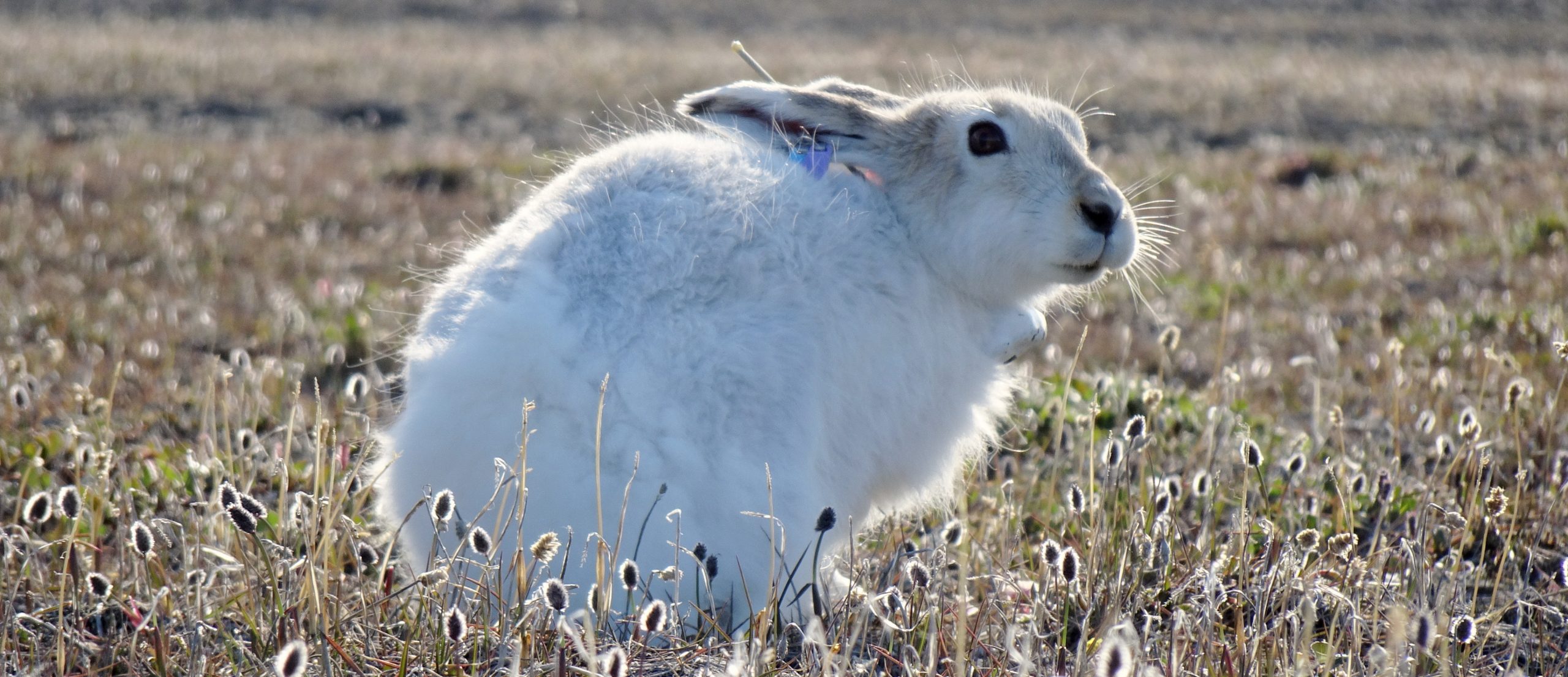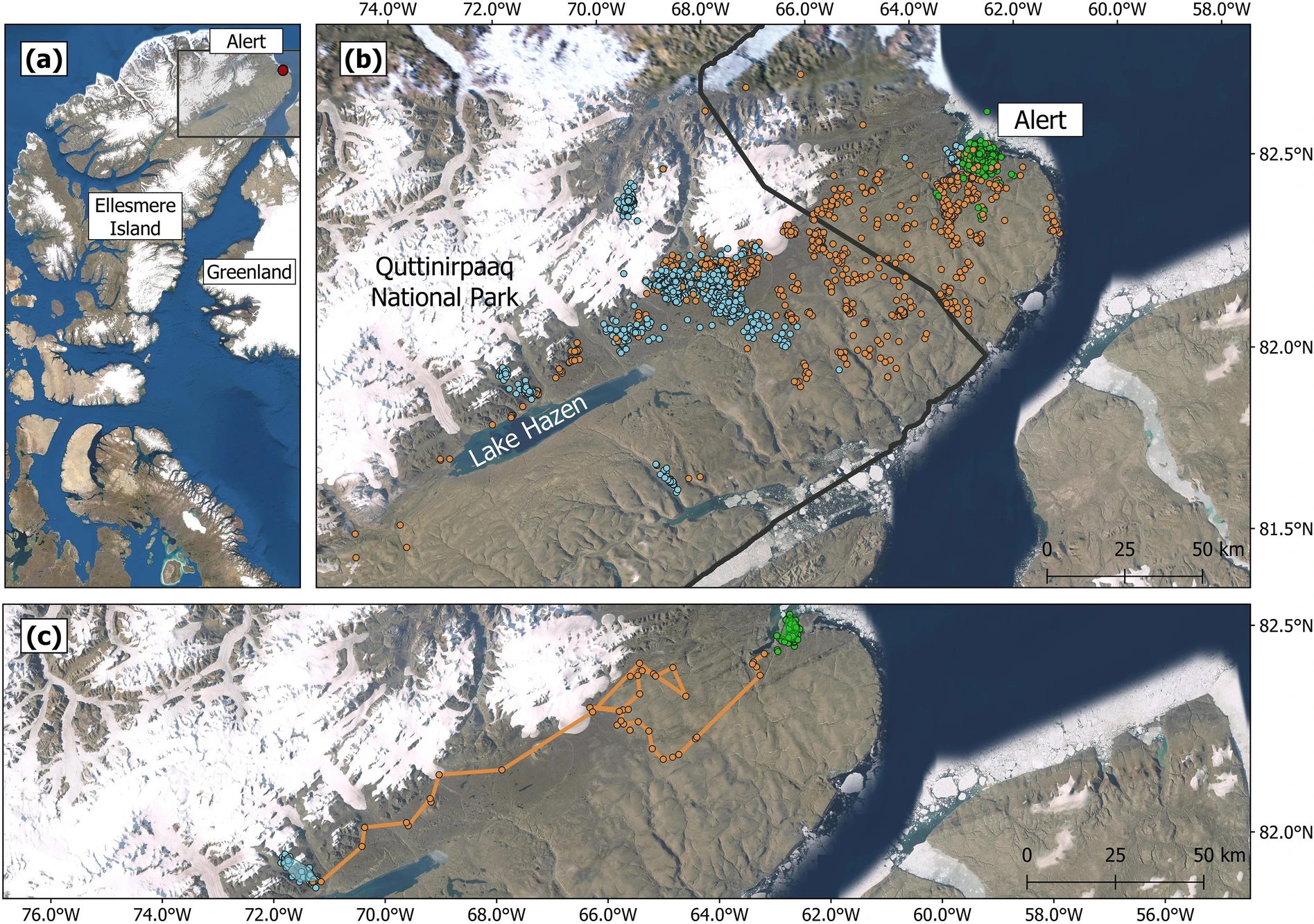← Back
Are the Arctic hares migrating?

A number of animals are migratory. The hares do not leap to mind when listing migrating animals. However, satellite telemetry confirms arctic hares very probably migrate in Northern Canadian Arctic. A lot of questions have still to be answered on these potential migrations.
Photo: An arctic hare with an Argos PTT (credit Sandra Lai)
Arctic hares (Lepus arcticus) are found in the whole Canadian Arctic and in a portion of coastal Greenland, areas which are in a large part polar deserts. Those herbivores are abundant, and an important part of the staple diet of multiple predators in those regions. The Arctic hare movements range is in debate, with a doubt on their ability to accomplish large-scale movements, contrary to some of their predators like the artic fox (see e.g., From Svalbard to Canada, the long travel of an arctic fox tracked by Argos or Unlocking the mysteries of the Arctic fox).
Tracking Arctic hares
Twenty-five adult Arctic hares (21 females, 4 males) were equipped with Argos PTTs at Alert, Ellesmere Island, Nunavut. They were tracked using satellite telemetry to investigate the existence of migration in this species in Canadian High Arctic.
More info about animal tracking with Argos
The arctic hares left their summer grounds around Alert between 11 August and 17 September. They arrived on their winter grounds in the Lake Hazen basin area for all of them from 10 September to 5 November, which means their relocation lasted slightly more than 40 days on average. During their large-scale movements, they increased their speed by more than three times (from 1.3 ± 0.5 km to 4.3 ± 1.6 km). The minimum cumulative distance traveled during relocation averaged 198 ± 62 km, with some hares having traveled more than 300 km. The record distance was set by a female having traveled over 388 kilometers in 49 days.

(a) Location of study area (rectangle) at the northeastern tip of Ellesmere Island. (b) zoom on the rectangle with locations of 25 hares, obtained by Argos telemetry between 15 June 2019 and 31 May 2020 (green circles: summer locations, orange circles: fall relocation, and blue circles: winter locations). (c) Summer range (green), relocation path (orange dots and line) and winter range (blue) of an Arctic hare collared at Alert and wintering in the Lake Hazen area (from [Caron-Carrier et al., 2022])
Migration seems confirmed, but more investigations are needed
Twenty-one of the tagged hares moved (84%), at about the same time, direction and far-ranging destinations. This strongly suggests a population-wide migration phenomenon.
No individual was tracked until the next summer, due to a very high winter mortality or to collar failure, so spring return to summer grounds could not be confirmed, which would be the definitive argument for a seasonal migration.
More tracking will be necessary to confirm the annual occurrence of the fall movements by a proportion of the Arctic hare population of Northern Ellesmere Island, and their return to their summer grounds. Then, the usual questions on migratory animals should also be investigated – which part of the population migrate (age, sex… ), their benefits in doing so, etc. In particular, Arctic hares may be moving to poorer foraging areas to avoid predators during the breeding season.
References & links
- Caron-Carrier, J., S. Lai, F. Vézina, A. Tam, and D. Berteaux. 2022. Long-distance, synchronized and directional fall movements suggest migration in Arctic hares on Ellesmere Island (Canada). Scientific Reports 12:5003. https://doi.org/10.1038/s41598-022-08347-1
- Lai, S., É. Desjardins, J. Caron‐Carrier, C. Couchoux, F. Vézina, A. Tam, N. Koutroulides, and D. Berteaux. 2022. Unsuspected mobility of Arctic hares revealed by longest journey ever recorded in a lagomorph. Ecology 103. https://doi.org/10.1002/ecy.3620
- Science News : https://www.sciencenews.org/article/arctic-hare-distance-record-biology
- The Wildlife Society: https://wildlife.org/arctic-hare-makes-epic-polar-journey/
- Nunatsiaq News: https://nunatsiaq.com/stories/article/bbyys-journey-scientists-track-arctic-hares-record-setting-travels-around-ellesmere-island/
- Atlas obscura: https://www.atlasobscura.com/articles/arctic-hare-long-distance-travel
- Twitter: https://twitter.com/Arctic_paws/status/1476950552563097609?ref_src=twsrc%5Etfw
- Twitter: https://twitter.com/Arctic_paws/status/1507005316977860614?cxt=HHwWjIC5kb7W-ukpAAAA


